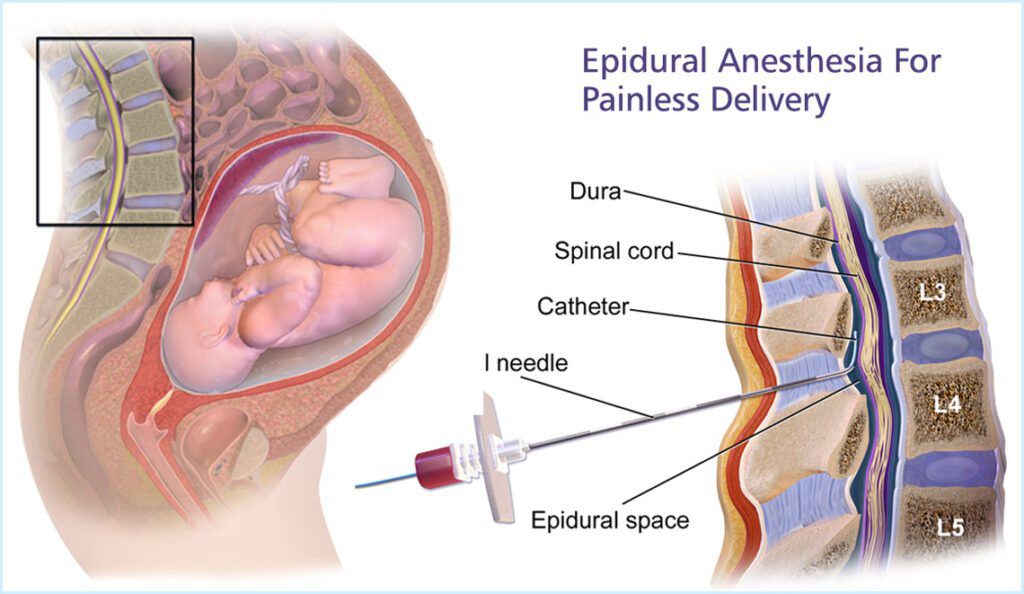Painless Delivery / Epidural Anesthesia
Painless Delivery / Epidural Anesthesia
Thinking about painless delivery and whether it is possible to achieve it?
Yes, painless normal delivery is achieved by administering epidural anesthesia to the mother during labor.
If you are keen on undergoing a painless delivery in Mumbai, then Dr. Shilpa Bansal Agrawal is the best delivery doctor one should consult. She has a remarkable track record of performing typical, safe deliveries.
When pregnant women are in the active labor stage- the process of delivery of a fully developed fetus, they start experiencing painful, regular uterine muscle contractions, which become more frequent and intense as the fetus moves into their pelvis. Such labor pain could even be caused due to pressure on the cervix. In every woman, labor pain is felt differently, depending upon the psychological and physiological status of the mother. About 70% of women feel labor pain as severe or unbearable.
In today’s time, epidural anesthesia is the most appropriate and effective pain-relieving technique among pregnant women. The procedure involves the placement of a thin hollow tube called a catheter in the lower region (epidural space) of the backside and the administration of painkillers through it. Epidural is a kind of regional anesthesia to provide pain relief in labor. It works by numbing the nerves that transmit pain impulses from the birth canal of the women to their brains. Most maternity packages offered to mother-to-be women at Harleys Cosmetic & Women Clinic include this service for painless delivery in Mumbai to provide pregnant women best childbirth experience.
Two kinds of epidurals vary in the painkiller drugs it contains:

Epidural anesthesia is provided by a licensed anesthetist in the active phase of labor of pregnant women. When it’s inserted, hardly any pain is felt by the women.
Before performing the technique, the expert gynecologist, Dr. Shilpa Bansal Agrawal, carries out a thorough examination of the abdominal region of the pregnant woman to ensure that it’s safe to use epidural anesthesia in their case.
During the procedure, a pregnant woman is instructed to sit comfortably up or lie on one of her sides and maintain her position. Next, the anesthetist carefully cleans and disinfects the backside of the mother using an antiseptic solution and thin infiltrates a local anesthetic agent to numb the lower back so that the mother does not feel pain while a large needle is inserted into her epidural space. At this time, a nurse assists pregnant women in making the right posture and remaining still for some time.
She likely receives fluids and even medications through an IV drip. Once the anesthetist identifies epidural space, a needle prick is made into the spine of the mother, which is next replaced with the catheter. This tube is kept in place and fixed along the back using tape. Through this tube, the anesthetist injects the medications from time to time within safety limits for both mother and her baby.
The drugs are adjusted according to the needs of the mother. For the standard epidural, the medication is administered into the epidural space- the area just outside the fluid-filled sacs around the spinal cord and for walking anesthesia, the medication is inserted within the fluids around the spinal cord. To maintain the effects of standard epidural until childbirth, the anesthetist may either use an auto-injector for continuous infusion of anesthetic through the catheter often left in place or a special sterile syringe to inject the anesthetic every time mother feels labor pain. Walking anesthesia is usually provided once, and the catheter is removed immediately afterwards.
Throughout the procedure, the vitals of the mother are kept in check. Lastly, the site where the needle was inserted is bandaged.
Dr. Shilpa Bansal Agrawal is one of the top gynecologists, providing the best painless delivery in Mumbai, with years of experience in providing safe, painless births. Therefore, one should not worry about the safety of the infant or the mother. She ensures that the labor is as painless as possible for the mother.
After the painless delivery, the mother can move around, but she needs to be careful not to slide into bed to avoid pulling out of her catheter. The labor pain significantly reduces, and the mother experiences bearable and easily manageable labor. The epidural prevents the mother from getting exhausted and helps her cope with her labor. However, at the end stage of the active labor phase, the mother can expect to experience some pressure in the rectum as the procedure cannot numb her because she needs to be aware of when and where she needs to push at the end of labor, to pass out the baby through the vagina.
Frequently Asked Questions About Epidural Anesthesia
Are there any side effects of epidural anesthesia?
Generally, epidural anesthesia is safe. But, possible side effects or risks includes:
Who cannot have painless delivery?
Pregnant women who have blood clotting disorders, neurological issues, and certain types of lower back surgeries are not recommended to have epidural anesthesia. Often, epidural or spinal anesthesia is chosen by pregnant women when the labor pain is too intense without any pain-relieving medications, the body can remain in a comfortable position throughout the procedure till delivery, and when there is a need for less hangover and fewer systematic medications than provided by general anesthesia or sedation.
How long does standard epidural anesthesia last?
The epidural catheter can be kept secure in place for up to 5 days, and the pain-relieving medication is given through it from time to time as and when the mother needs it.
What is the best timing to perform painless delivery?
The best timing to carry out the epidural is decided by the mother herself. Usually, it is done when the cervix of the mother is 3 to 8 cm dilated. However, if the mother is suffering from any specific medical condition or is experiencing intense labor pain, the epidural timing could be much earlier. In some cases, painless delivery may even be performed when the cervix of the mother is more than 8 cm wide open and the fully developed fetus is not lying too deep in the pelvis of the mother.
What preparation is required before undergoing painless delivery?
Following pre-procedural instructions must be followed by pregnant women who have chosen to go ahead with painless delivery.
Many women today choose painless delivery methods to avoid experiencing extreme pain during labor. The epidural is one of the most popular solutions for painless childbirth that most women prefer. One can ask Dr. Shilpa Bansal Agrawal about the pain treatment options accessible to one during labor and then make an informed decision. Even if one does not want to use an epidural, one can still discuss the alternatives with the doctor to ensure a peaceful birth.

Harleys Cosmetic and Womens Clinic
101-102, Jyoti Tower, DN Nagar,
Next to Nav Chaitanya, off Link Road,
Andheri West, Mumbai - 400053. Locate us
Request An Appointment
